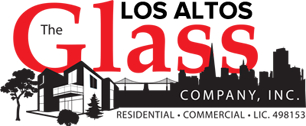Los Altos Glass Works offers custom solutions for commercial and residential applications. With over 35 years experience, we can fabricate and install any type of glass at a very competitive price.
Call today for a free quote (650) 646-4973 or click here to request a quote online.

Beveled Glass - Beveled glass has an angle cut around the edge of the glass to create a prism effect. The effect is used most often to adorn thick mirrors or windows. The effect changes depending on the thickness of the glass and the angle of the bevel. Glass can be beveled whether it is smooth, textured, clear or colored.
Back Painted Glass - back painted glass is glass that has been painted on the back side, so that the color shines through when viewed from the front. It was originally used for industrial work, for example, to hide heating ducts and pipes, but it has branched out into more decorative roles. Back painted glass is now commonly used in commercial and residential buildings for items such as counter tops, back splashes, spandrel glass, and colored walls.
Bullet Proof Glass - Bullet proof glass is the fusion of two or more substances to make a material that is very resistant to high-velocity impacts, such as that from a bullet. Generally, it is not glass at all but rather acrylic, or solid plastic. Acrylic is much easier to work with and install than glass. Bullet proof glass can also be formed by combining two or more layers of soft and hard glass. The soft layer is flexible, allowing it to bend instead of shattering, while the hard glass creates a strong barrier. Alternatively, a sheet of glass may be fused with polycarbonate or a transparent plastic resin. Bullet proof glass may vary from three-quarter to three inches in thickness.
Colored Glass - Colored glass is produced by adding impurities in the sand mixture that is used to manufacture the glass. For example, dark glass units are made by adding iron impurities and sulfur produced as a result of coal burning during the glass melting process. Glass can also be colored using minerals and pigments obtained from purified metal salts. Some of the popular impurities used to color glasses include gold chloride (in case of ruby glass) and uranium oxide (in case of uranium glass).
Curved glass - Made by cutting a sheet of glass and polishing it until clean. The glass is then subjected to UV rays to check for impurities and dust particles in order to protect it from cracks and shattering. A steel mould is constructed with the radius and other dimensions equal to the desired shape. The glass is then placed on the mould and painted with appropriate chemicals to prevent it from sticking to the mould. The mould is loaded into the kiln and heated at a temperature of 700 degree Celsius, hot enough to soften the glass through loosening the silica molecules in it. The glass starts to fit to the profile of the mould and gradually cools down over a period of three hours.
Decorative Glass - Decorative glass is used in decorative doors, windows and cabinets for homes and offices. It is the ideal glass for spaces where privacy and elegance are required. The glass is etched, sandblasted, cut, textured and customized to meet individual needs and requirements. These glasses create an attractive look and dramatic effect in any space while pouring the light from corner to corner and creating an open feel.
Digitally Printed Glass - Digitally printed glass is produced by combining toughened glass with the latest digital printing technique. This process has been able to revolutionize modern interior design and take it to a whole new level by offering a wide range of wall coverings and splash-backs. The printed glass thus created is extremely versatile and can be made to blend with any environment - domestic or commercial. The visual results are full of depth, color, brilliance and contrast.
Etched Glass - Etched glass is the result of etching or creating art on the glass's surface using acid and/or abrasive materials. The end product has a white or frosted finish. The technique is used to decorate the glass after it is blown and cast, and can be found in a wide range of decorative elements, such as doors, windows, furniture, vases, dishes and glass platters.
Fire Rated Glass -Fire rated glass is produced in such a manner that the glass is thoroughly glazed to protect itself from flames and smoke, and to prevent the flame from spreading. The materials used to manufacture this glass include tempered glass and glass ceramics. Fire rated glass used in panel units contain multilayer assemblies to block conductive heat and energy. They are suitable for use in walls, floors, ceiling and glass doors that are susceptible to fire damage.
Float Glass - Float glass is produced from molten glass that is made to float on a molten metal bed, usually tin. The metal used here varies from manufacturer to manufacturer - some use lead or alloys with low melting point. This technique of glass preparation gives it a flat surface along with uniform thickness.
Frosted Glass - Clear sheet glass is either sandblasted or acid etched to form frosted glass. The end result is a translucent glass sheet that scatters and transmits light passing through it while blurring images. Frosted glass units are also produced with frosting spray. The spray is made to adhere to the glass and the resulting finish is a slightly pebbled glass surface that obscures clarity. The glass frosting is prevented from seeping with the help of stencils that are laid down with tape.
Glass Tiles - Glass tiles are produced by combining various glass pieces into one consistent shape. This type of glass unit is used in floors and walls. Modern glass tile technology involves reusing broken glasses and recreating it to form 'green glass' tiles. Today, it is commonly found in spas, kitchens and bathrooms.
Heat Resistant Glass - Heat resistance glass is more resistant to heat than any other ordinary type of glass. This glass is more suitable for cooking, construction and industrial applications where high temperature is likely to cause normal glass to break. Heat resistance glass has a lower thermal expansion coefficient. In other words, it expands more slower than normal glasses when heated, thus preventing it from shattering.
Iced Glass -The glass is combined in layers (laminated) to form iced glass. The center panel used in the lamination is cracked with a sharp object. The pattern thus created has an iced appearance throughout the sheet. The outer layer is polished and made smooth. This type of glass is used as table tops, shelves, back-splashes and counter-tops. The thickness of the product depends on the number of layers used.
Insulated Glass - Double or triple glass panes which are separated by an air or gas space that help to keep the heat in a building. Insulated glass is produced by taking glass's thickness into consideration. A typical sheet of insulated glass uses the base glass with thickness ranging anywhere from 3 mm to 11 mm. Insulated glass can also be produced from tempered glass. A standard insulated glass contains glass layers of same thickness, but special requirements such as security and sound-proof may require various thicknesses for the unit
Low E Glass - Also known as low-emissivity glass or low thermal emissivity glass, is a glass that emits radiant heat energy in low levels through its surface. Unlike other types of glass where the materials absorb and allow radiant energy to conduct through the glass, Low E glass has a metallic reflective coating surface that emits radiant energy with a different wavelength interval. The radiation temperature ranges anywhere between 40 to 60 degree Celsius.
Low Iron Glass - Glass in which most of the iron oxide has been removed at the time of production. The clarity is better than that of regular glass.
Laminated Glass -Laminated glass units are used for safety purpose. It is a type of safety glass that remains stable by holding the elements or materials together. The entire unit is held in place in the event of breakage by Polyvinyl Butyral or PVB placed in between a couple of glass layers. The inner layer thus prevents the glass from breaking up into parts and bits in addition to giving the glass unit the needed sound insulation rating. PVB also protects the glass by blocking around 99% of UV radiation.
Obscure Glass - Obscure glass is a type of glass that transmits light but blocks any view of the objects behind it. This glass is very similar to frosted glass or translucent glass, in fact it is frosted to the point where the object is completely hidden. Most obscure glasses have rough texture on the outside and Low-E glass on the inside. Some manufacturers produce obscure glass units that are patterned or something with a nice decorating touch.
Opaque Glass - Opaque glass is produced by acid etching clear glass. The light that falls on this glass is scattered during transmission and as a result, the object behind it is literally made unseeable. Opaque glass is sometimes referred to as frosted glass.
Plate Glass - Plate glass, known as sheet glass or glass pane or simply flat glass, is produced from plane glass and used for glass doors, windows, walls and vehicle windshields. The glass comes in various forms, sizes, and sometimes slightly bent for automotive and modern construction purposes.
Plexiglass - This type of glass is actually an acrylic sheet of clear or opaque material. It is lighter in weight, safer to use than most other glass types and often replaces regular glass. In addition, plexiglass is transparent in nature, thermoplastic and shatter resistant unlike other forms of glass.
Silk Screened Glass - Silk screened glass units have graphic images on them giving the illusion of patterned, textured or etched glasses. The process of printing on the glass begins with applying ceramic paint to the surface, followed by drying and polishing. This type of glass provides privacy in an interior environment and reduces glare from external factors.
Safety Glass - Safety glass comes in various forms such as tempered glass, wire mesh glass and laminated glass, and contains additional safety features. The safety feature makes it less likely to break or pose threat when shattered.
Sound Proof Glass - Sound proof glass prevents sound from penetrating through the glass. This type of glass is most commonly found in homes and buildings where noise issue exist due to various factors like traffic, airports and entertainment venues. While glass in general is sound proof to some extent, a real sound proof glass makes it impossible for the sound to enter or leave the surface.
Spandrel Glass - Spandrel glass is used to cover construction materials, such as section of buildings, columns, floors, ceilings and other spaces. It is durable and designed in an aesthetically appealing manner for the purposes it serves. Spandrel glass units are typically made to withstand high heat in order to protect the things it encloses. Sometimes, the glass surface is permanently fused with ceramic coated tempered glass for additional durability.
Stained Glass - Stained glass is made by cutting colored glass that are produced by the addition of salts into specific shapes and embedding it into a mosaic. The glass is procured and soldered with metal strips to give the object the required stability and strength. The sheets can be created in a variety of textures to give the designs a jeweled look.
Starphire Glass - Starphire Glass contains low iron particles and is used extensively for glass trophies. Starphire glass is lead free and the trophy can be made to look like a crystal product with a light blue tint. The low iron particles give the glass the much needed clarity than a standard glass.
Tempered Glass - Tempered glass, commonly referred to as toughened glass, is a type of glass where the properties are altered using chemical treatments and heat energy to give it more strength and stability than a normal glass. Tempering the glass means making the outer surface of the glass undergo compression and the inner surface tension. The stress induced on the glass crumbles it into small granular chunks instead of big sharp fragments when broken.
Transparent Glass - This type of glass has a clear view and one color. Any combination of colors will lead up to a spectrum. The materials that make up transparent glass allow every light wave to pass through them making the object on the other end clear and visible.
Textured Glass - Textured glass or hammered glass is produced when the rolls or sheets of glass are imprinted with a texture. The result product is a glass with smooth surface on one side and textured pattern on another. Textured glasses are also referred to as muffle and granite.
Translucent Glass - Translucent glass is a type of glass that allows only a part of the light to pass through it, thus making the things on the other side unclear or vague. The materials used to produce translucent glass play a major role in the way it looks. This allows the manufacturer to experiment with combination of elements and the designer to work with other elements of a room and shape them accordingly for a dramatic end result.
Wired Glass - Wired Glass is a glass with a wire mesh embedded into it during production. The presence of wire mesh makes the glass unit resistance to impact by retaining the glass pieces in place. This glass is used as a fire-resistant product for low-cost operations. Wired glass units are either clear or tinted with electricity or aerosol to give it a golden-yellow or violet-rose hue.






